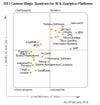Gartner BI Magic Quadrant: Winners & LosersGartner BI Magic Quadrant: Winners & Losers
Tableau and QlikTech move up. See who moves down in Gartner's ranking of business intelligence vendors.

The more things change, the more they stay the same. That adage could apply to Gartner's Magic Quadrant for Business Intelligence and Analytics Platforms for 2014, released last week, as the same vendors show up in the prized Leaders quadrant.
[ Want our analysis of Gartner's latest BI quadrant? Read Gartner BI Magic Quadrant 2015 Spots Market Turmoil.]
At first glance, the new report delivers a very different-looking positioning of vendors than the 2013 quadrant (as shown below). On closer inspection, however, you'll find that the same 10 vendors are still in the Leaders quadrant. And the same two vendors, Birst and Logi Analytics, remain in the Challengers quadrant, albeit in changed positions. The only new news, quadrant-wise, is the emergence of Alteryx and Panorama Software into the Visionaries quadrant. (Tableau Software is one of several vendors offering free downloads of the complete report, but Tableau does not require registration.)
In Gartner's defense, BI and analytics suites don't tend to change dramatically in one year, so incremental shifts are to be expected. What's more, within each quadrant there are notable shifts in vendor positioning. First, all vendors moved to the left on the horizontal Completeness of Vision axis. That's because Gartner has raised its expectations, something it must do each year so vendors never get to the top-right corner and start resting on their laurels.
The broad shift to the left is tied to the years-long ascendance of data-discovery platforms from the likes of Tableau Software, QlikTech, and Tibco Spotfire. Data discovery is now driving the majority of new software license revenue, but these platforms tend to lack "the necessary features in relation to governance, administration, and scalability," Gartner reports.
Meanwhile, incumbents like IBM, SAP, Oracle, and MicroStrategy that tend to do well on governance, administration, and scalability have had "limited success in delivering 'good enough' data discovery capabilities," Gartner writes. In other words, practitioners want and need the ease and speed of data-discovery platforms, but they shouldn't have to give up admin control and the assurance of data-modeling and data-quality consistency across high-scale deployments.
"The race is on to fill the gap in governed data discovery," Gartner writes. "Next year, Completeness of Vision positions will in part be determined by which vendors achieve success in addressing this critical market requirement."

As for the vendors that bucked the broad trends, Tableau Software and QlikTech both moved to the right on the Completeness of Vision axis, but Tableau Software also moved up significantly to become the top-ranked vendor on the Ability to Execute axis.
"Tableau's strong survey results for customer satisfaction, coupled with its market momentum, are behind its dominant Ability to Execute position," Gartner reports. "Surveyed customers identified ease of use for end users and developers, and functionality, as their main reasons for choosing Tableau. In fact, 73% selected Tableau's product for its ease of use for end users, which places it among the top two vendors in the survey."
Oracle and MicroStrategy sank significantly on the Ability to Execute axis, though they remain in the Leaders quadrant. Oracle's decline was tied to customer survey results that showed that "recent Oracle BI releases received scores for customer experience, including support and product quality, that were among the lowest," Gartner states. At MicroStrategy, "customers identified ease of use for both developers and business users as an ongoing concern. They also reported issues with software and support quality. MicroStrategy received the second-lowest result of any vendor in the survey for both of these criteria."
As for Alteryx and Panorama, the two vendors that jumped into the Visionaries quadrant, Gartner lauded Alteryx for "the highest capability and use scores for ad hoc reporting and querying, geospatial and location intelligence, the second-highest for support for big data sources, and the third-highest for business user data mashups and modeling." Panorama was praised for its "high marks for ease of use, breadth of use, and enabling users to conduct complex types of analysis. Panorama also received high marks on critical satisfaction metrics for product functionality, support and product quality."
Birst and GoodData also rose significantly in Gartner's latest report, with their gains tied to growing acceptance of cloud-delivered BI and analytics capabilities.
Gartner started making greater use of customer-survey-based information in its BI quadrant rankings several years ago, and this year more than ever this feedback seems to be making the difference in vendor rankings. That's a good thing, and it has generated a long list of "cautions" in the descriptions of vendors large and small. Read the full report and buyer beware. [Author's note: This year Gartner has issued its first-ever Magic Quadrant specifically on advanced analytics products, a report we plan to cover in a separate article.]
Engage with Oracle president Mark Hurd, NFL CIO Michelle McKenna-Doyle, General Motors CIO Randy Mott, Box founder Aaron Levie, UPMC CIO Dan Drawbaugh, GE Power CIO Jim Fowler, and other leaders of the Digital Business movement at the information Conference and Elite 100 Awards Ceremony, to be held in conjunction with Interop in Las Vegas, March 31 to April 1, 2014. See the full agenda here.
About the Author
You May Also Like






